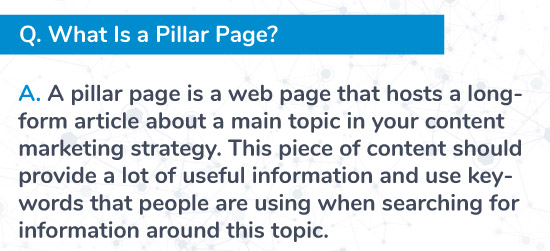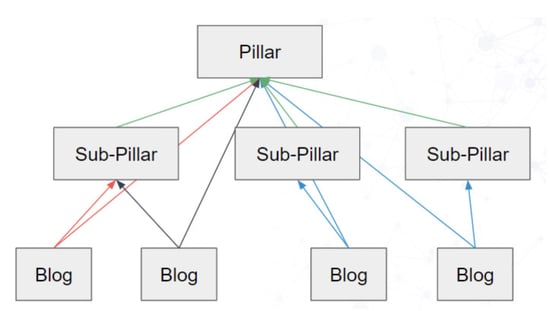How Do You Create a Pillar Page?
March 25, 2022 •Erica Kempf

A pillar page is a huge part of your overall content development, so knowing how to create one is very important to your entire SEO pillar plan. The basics of pillar page design tell us that our pillar page should be the home for our largest piece of content on a topic, with sub-pillars and blogs that link back to it with more information on different topic aspects.
Let’s go through all the things you need to know to be successful in creating your own pillar page.
What Is a Pillar Page?
A pillar page is a web page that hosts a long-form article about the main topic in your content marketing strategy. This piece of content should provide a lot of useful information and use keywords that people are using when searching for information around this topic.
A key component to this strategy is that other content you create around this same topic links back to the pillar page. Additional content in a pillar strategy comes in the form of shorter articles that discuss smaller topics within the pillar (sub-pillars), which tend to be around 1,500 words. Then individual blog posts that focus on a very narrow topic and are shorter, in the range of 750 words.

The pillar page can also be thought of as the center of a spider web that makes up a content cluster, where multiple different blogs and support pillars related to the pillar link back to it.
Another phrase that is used to describe a pillar page is a 10x content pillar page. This is referencing a page that contains ten times as much useful content as other, related pages.
This really illustrates how important your pillar page is, and how much useful and high-quality information you want to try and include in it. You can see a great example of a pillar page if you look at the one this blog links to, DemandJump’s SEO Pillar.
What Should a Pillar Page Look Like?
Once you know the structure of your pillar strategy and of the article itself, what exactly should go into a pillar page? Here are the highlights:
- Readable - The average reader will spend less than a minute on an article. Make your pillar page well written so they want to keep reading, and easy to skim to get the answer to their question quickly.
- Useful - You want to provide value to your reader with high-quality information and answers to their questions that are easy to find and helpful.
- Keywords - Make sure you include 18-20 keywords and phrases that people are actually using when they search for this type of information, this way your article can be found by the people looking for it. DemandJump’s tools make knowing what these are easy!
- Length - Around 3,000 words is the goldilocks zone for pillar pages, not too short to be unhelpful, not too long to be read.
How Do I Make a Pillar Page Structure?
The first thing will be to come up with the overall topic this pillar and all its related support pillars and blogs will be addressing. Sometimes this topic will be obvious, and sometimes it will take more work to come up with the best option for a topic that is broad enough to write a good range of content for, but specific enough to reach a specific audience.
When we are answering the question of “how do you structure a pillar page?” an example can help a lot. Again, let’s take a look at the pillage page structure this article is a part of as an example.
Pillar:
SEO Pillar
Sub Pillar:
Pillar Page Design
Blogs:
What is a pillar page example?
What is a pillar page strategy?
How do you create a pillar page? (you are here)

How Do You Write Pillar Page Content?
Once you have the topic for your pillar page, it is time to decide all the areas of this topic that are important to cover. A good way to begin getting the structure of the actual article you will be writing for the pillar is to create an outline for the piece. To use a light-hearted example, if you were making an outline of the pillar page for “How to make a PB&J sandwich”, it might look something like this:
How to Make a Peanut Butter and Jelly Sandwich
- Ingredients
- Bread
- Peanut butter
- Jelly
- Construction
- Order of assembly
- Toasted vs untoasted
- Tools
- Knife vs spoon
- Plate size
When you sit down to write the content of the pillar page, you can use this outline structure as the structure for the article itself. The main headers can be the main bullet points, and you can break them down and provide more information on each part with additional levels of headers.
Jump into Your Own Content Building!
This pillar structure is proven to drive traffic and increase your first page rankings, so customers can find you. Now that you know the strategy to create your own pillar page, it’s time to get started with your own content creation.
DemandJump can help with every step of the way, from helping you determine what topics would make the best pillars for your business, to showing you the exact keywords people are using to search for your services.
See just how easy it can be.
Featured Articles
Categories
- Attribution Tracking (13)
- Channel Optimization (11)
- Consumer Insights (68)
- Content Marketing (251)
- Data Science (8)
- Digital Marketing (6)
- Digital Transformation (26)
- Enterprise (10)
- Lead Generation (14)
- Market Intelligence (8)
- Marketing Analytics (39)
- Marketing Attribution (57)
- Marketing Management (153)
- Marketing Operations (86)
- Organic Search (222)
- Paid Search (52)
- Pillar-Based Marketing (63)
- Programmatic Advertising (9)
- SaaS Content (14)
- SaaS Marketing (29)
- Search Marketing (111)
- SEO Keyword Research (28)
- SEO Pillar (18)
- SEO Strategy (46)
- SMB (5)
- Website Content (12)


